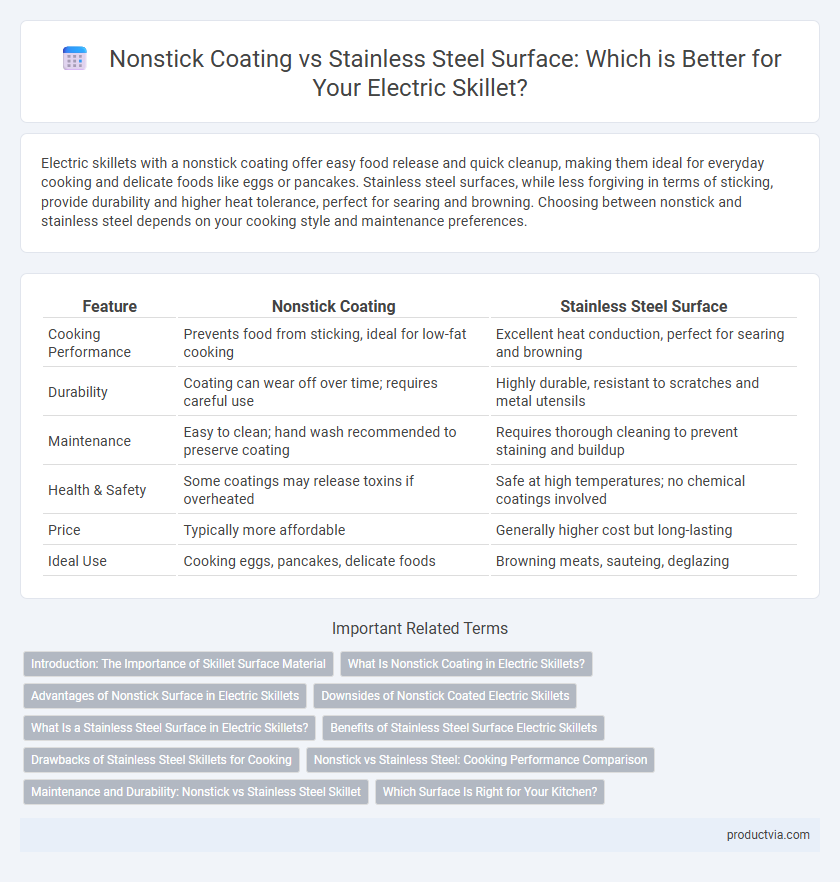Electric skillets with a nonstick coating offer easy food release and quick cleanup, making them ideal for everyday cooking and delicate foods like eggs or pancakes. Stainless steel surfaces, while less forgiving in terms of sticking, provide durability and higher heat tolerance, perfect for searing and browning. Choosing between nonstick and stainless steel depends on your cooking style and maintenance preferences.
Table of Comparison
| Feature | Nonstick Coating | Stainless Steel Surface |
|---|---|---|
| Cooking Performance | Prevents food from sticking, ideal for low-fat cooking | Excellent heat conduction, perfect for searing and browning |
| Durability | Coating can wear off over time; requires careful use | Highly durable, resistant to scratches and metal utensils |
| Maintenance | Easy to clean; hand wash recommended to preserve coating | Requires thorough cleaning to prevent staining and buildup |
| Health & Safety | Some coatings may release toxins if overheated | Safe at high temperatures; no chemical coatings involved |
| Price | Typically more affordable | Generally higher cost but long-lasting |
| Ideal Use | Cooking eggs, pancakes, delicate foods | Browning meats, sauteing, deglazing |
Introduction: The Importance of Skillet Surface Material
Nonstick coatings in electric skillets provide effortless food release and easy cleanup, making them ideal for low-fat cooking and delicate foods like eggs and pancakes. Stainless steel surfaces offer superior heat retention and durability, promoting even browning and the ability to deglaze for rich sauce creation. Choosing between nonstick and stainless steel hinges on cooking style preferences, maintenance willingness, and long-term skillet performance.
What Is Nonstick Coating in Electric Skillets?
Nonstick coating in electric skillets is typically made from materials like Teflon or ceramic, designed to prevent food from sticking during cooking and enable easy cleanup. This coating provides a smooth, slick surface that requires less oil or fat, enhancing healthier cooking and precise temperature control. Unlike stainless steel surfaces, nonstick coatings offer enhanced convenience for cooking delicate foods like eggs and pancakes without worrying about food residue.
Advantages of Nonstick Surface in Electric Skillets
Nonstick coatings in electric skillets offer superior food release and require less oil, promoting healthier cooking and easier cleanup compared to stainless steel surfaces. These surfaces prevent food from sticking, reducing the risk of burning and enabling uniform cooking with minimal temperature adjustments. Nonstick electric skillets are especially advantageous for delicate foods like eggs and pancakes, enhancing cooking efficiency and preserving food appearance.
Downsides of Nonstick Coated Electric Skillets
Nonstick coated electric skillets can deteriorate quickly, especially when exposed to high heat, resulting in peeling and potential ingestion of harmful chemicals like PFOA. These coatings are often less durable than stainless steel surfaces, reducing the skillet's overall lifespan and requiring more frequent replacement. Users must avoid metal utensils to prevent scratching, limiting cooking versatility compared to the more resilient stainless steel electric skillets.
What Is a Stainless Steel Surface in Electric Skillets?
A stainless steel surface in electric skillets consists of a durable, non-reactive metal known for its resistance to rust and corrosion, providing even heat distribution for precise cooking. Unlike nonstick coatings, stainless steel requires proper seasoning or oil to prevent food from sticking, promoting a healthier cooking method without the risk of chemical coatings degrading. Its robust construction allows for high-temperature cooking and better browning, making it ideal for searing and frying tasks in electric skillets.
Benefits of Stainless Steel Surface Electric Skillets
Stainless steel surface electric skillets offer superior durability and resistance to scratching compared to nonstick coatings, making them ideal for high-heat cooking and metal utensil use. They provide even heat distribution and maintain cooking temperatures more effectively, enhancing food browning and searing. Unlike nonstick options, stainless steel surfaces do not release chemicals or degrade over time, ensuring long-term safety and performance.
Drawbacks of Stainless Steel Skillets for Cooking
Stainless steel surfaces in electric skillets tend to have poor nonstick properties, causing food to stick and making cleanup more difficult. These skillets often require more oil or fat to prevent sticking, which can affect the healthiness of meals. Moreover, stainless steel can cause uneven heating compared to nonstick coatings, leading to inconsistent cooking results.
Nonstick vs Stainless Steel: Cooking Performance Comparison
Nonstick coating on electric skillets offers superior food release and easier cleanup, making it ideal for cooking delicate items like eggs and pancakes. Stainless steel surfaces excel in high-heat searing and browning, providing better durability and resistance to scratches or metal utensils. Choosing between nonstick and stainless steel depends on the desired cooking performance and maintenance preferences for precise heat control or effortless food release.
Maintenance and Durability: Nonstick vs Stainless Steel Skillet
Nonstick coatings on electric skillets require gentle cleaning with non-abrasive materials to preserve their surface and prevent peeling, offering ease of maintenance but limited lifespan due to wear. Stainless steel surfaces demand more rigorous cleaning, often needing scrubbing to remove food residue, yet provide superior durability and resistance to scratches, extending the skillet's functional lifespan. Choosing between nonstick and stainless steel hinges on balancing maintenance convenience with long-term durability expectations.
Which Surface Is Right for Your Kitchen?
Nonstick coating in electric skillets offers effortless food release and easy cleaning, making it ideal for low-fat cooking and busy kitchens. Stainless steel surfaces provide superior heat retention and durability, preferred for high-heat searing and browning techniques. Choosing between these depends on your cooking style: nonstick for convenience and delicate foods, stainless steel for longevity and versatile culinary tasks.
Nonstick coating vs stainless steel surface for electric skillet Infographic

 productvia.com
productvia.com